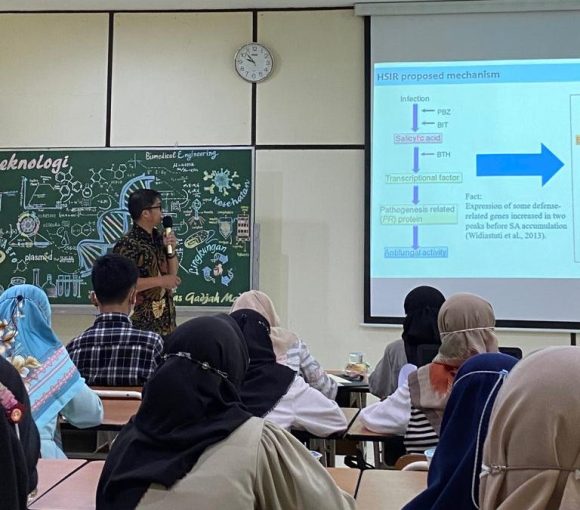
The Study Program of Biotechnology, Graduate School of Universitas Gadjah Mada held a public lecture on Friday, December, 9th, 2022 with Mr. Agung Dian Kharisma, S.Pd.Si., M. Biotech., Ph.D. who is the Manager of PT. Widya Teknologi Hayati. PT Widya Teknologi Hayati is a biotechnology research company focusing on exploring and producing bioactive compounds. The material presented in this public lecture is related to the induction of resistance in plants by heat shock treatment. Every plant already has an innate immune system, but sometimes it is not strong enough to fight pathogens. The alternative method of heat shock is one way to improve this.
Generally, there are two ways to increase plant resistance: plant breeding and induction. The latest in plant breeding methods is the production of genetically modified (GMO) plant products by applying molecular techniques such as plasmids or genes that are inserted into target plant cells or organs. One of the studies at PT. Widya Teknologi Hayati is to suppress one of the genes by using a pathway. The gene is modified using E. coli, Agrobacterium, or DNA constructs. Then the modified Agrobacterium can be inoculated into the target plant. Furthermore, genetically modified plants are developed and selected to get the best results. The latest is using genome editing with the CRISPR method.
The second way that can be used is to bring up plant resistance by the induction method. This method is done by triggering a plant so that its innate resistance increases. Heat shock treatment is a proven method to induce plant resistance. Mr. Agung Dian Kharisma, Ph.D. also exemplifies one of the images to protect plants from disease by inducing plant resistance. There is also a case that occurred in Japan where many farms use greenhouses. Under these conditions, Mr. Agung Dian Kharisma, Ph.D. during the summer, if the greenhouse is closed, the plants that are affected by the disease are less than the greenhouse that is opened. It was explained that the temperature inside a greenhouse, in Japan can reach 45°C and even reach 60°C. For this reason, when winter comes, farmers in Japan usually use heaters. This phenomenon is described as an unexpected phenomenon that triggers research on heat shock-induced treatment. As a result of the closed greenhouse, the infection was much lower due to heat shock. This later became the background of the research conducted by Mr. Agung Dian Kharisma, Ph.D.
Then the preliminary research was carried out in a conceptual manner which gave the result that plants without heat shock were compared to plants without heat shock treatment. The results obtained from both were almost similar without any disease. After this comparison, it was suspected that heat shock treatment was even stronger as an inducer of plant resistance compounds. Then the next process is a trial using hot water as a heat shock treatment. Using temperature optimization which is proven to be able to fight exposure to fungi. Then the results obtained were developed in a more comprehensive study.
Several studies have also been carried out before which are displayed from 2012 to 2021. Starting with checking gene expression to its application in the field. In addition, Mr. Agung Dian Kharisma, Ph.D. conclude that heat shock has the potential to induce plant resistance as an alternative method. Practically the heat shock method has been carried out using a hot water sprayer with a temperature of around 50 °C. The application of this method gave fresher yields to plants treated with heat shock and paler yields to plants without heat shock treatment. The latest is to do a comparison with UV-B to induce resistance. The effect of using UV-B is almost the same as HS but not systemic. In Indonesia, the use of the heat shock method to induce resistance in plants is still a great opportunity to be developed.
Author : Buhairi Rifqa Moustafid


